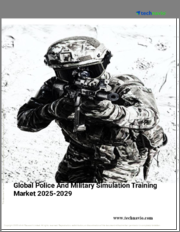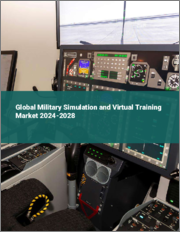
|
시장보고서
상품코드
1658020
군사 시뮬레이션 및 가상훈련 시장 규모, 점유율, 성장 분석 : 플랫폼 유형별, 훈련 유형별, 용도별, 지역별 - 산업 예측(2025-2032년)Military Simulation and Virtual Training Market Size, Share, and Growth Analysis, By Platform Type (Flight Simulation, Vehicle Simulation), By Training Type (Live Training, Virtual Training), By Application, By Region - Industry Forecast 2025-2032 |
||||||
군사 시뮬레이션 및 가상훈련 시장 규모는 2023년 143억 달러로 평가되며, 2024년 149억 9,000만 달러에서 2032년 218억 1,000만 달러로 예측 기간(2025-2032년) 동안 4.8%의 CAGR로 성장할 것으로 예상됩니다.
군사 시뮬레이션 및 가상훈련 시장은 군사적 준비와 효율성을 높이기 위한 현실적인 훈련 환경에 대한 수요 증가에 힘입어 향후 몇 년 동안 큰 성장을 이룰 것으로 예상됩니다. 가상현실(VR) 및 증강현실(AR) 기술의 발전은 정교한 시뮬레이터와 함께 실제 전투 시나리오를 정확하게 재현하기 때문에 이러한 확장의 최전선에 있습니다. 주요 촉진요인으로는 비용 효율적인 훈련 솔루션의 필요성, 현대 군사 작전의 복잡성, 훈련 훈련 중 대원들의 위험을 최소화하는 것에 대한 강한 관심을 들 수 있습니다. 또한, COVID-19 팬데믹은 다양한 군사 및 국방 분야에서 가상훈련 솔루션의 채택을 가속화하여 이 분야의 시장 기업들에게 유리한 상황을 조성하고 있습니다.
목차
소개
- 조사 목적
- 조사 범위
- 정의
조사 방법
- 정보 조달
- 2차와 1차 데이터 방법
- 시장 규모 예측
- 시장 가정과 제한
주요 요약
- 세계 시장 전망
- 공급과 수요 동향 분석
- 부문별 기회 분석
시장 역학과 전망
- 시장 개요
- 시장 규모
- 시장 역학
- 성장 촉진요인과 기회
- 성장 억제요인과 과제
- Porters 분석
주요 시장 인사이트
- 핵심성공요인
- 경쟁 정도
- 주요 투자 기회
- 시장 생태계
- 시장 매력 지수(2024년)
- PESTEL 분석
- 거시경제 지표
- 밸류체인 분석
- 가격 분석
- 사례 연구
- 규제 분석
군사 시뮬레이션 및 가상훈련 시장 규모 : 플랫폼 유형별 & CAGR(2025-2032년)
- 시장 개요
- 비행 시뮬레이션
- 차량 시뮬레이션
- 전장 시뮬레이션
- 가상 부트 캠프
- 기타
군사 시뮬레이션 및 가상훈련 시장 규모 : 훈련 유형별 & CAGR(2025-2032년)
- 시장 개요
- 라이브 훈련
- 가상 훈련
- 건설적 훈련
군사 시뮬레이션 및 가상훈련 시장 규모 : 용도별 & CAGR(2025-2032년)
- 시장 개요
- 육군
- 공군
- 해군
군사 시뮬레이션 및 가상훈련 시장 규모 : 지역별 & CAGR(2025-2032년)
- 북미
- 미국
- 캐나다
- 유럽
- 독일
- 스페인
- 프랑스
- 영국
- 이탈리아
- 기타 유럽
- 아시아태평양
- 중국
- 인도
- 일본
- 한국
- 기타 아시아태평양
- 라틴아메리카
- 브라질
- 기타 라틴아메리카
- 중동 및 아프리카
- GCC 국가
- 남아프리카공화국
- 기타 중동 및 아프리카
경쟁 정보
- 상위 5개사의 비교
- 주요 기업의 시장 포지셔닝(2024년)
- 주요 시장 기업이 채용한 전략
- 최근의 시장 동향
- 기업의 시장 점유율 분석(2024년)
- 주요 기업 개요
- 기업 상세
- 제품 포트폴리오 분석
- 기업 부문별 점유율 분석
- 매출 전년비 비교(2022-2024년)
주요 기업 개요
- Lockheed Martin Corporation(United States)
- BAE Systems plc(United Kingdom)
- Thales Group(France)
- CAE Inc.(Canada)
- Elbit Systems Ltd.(Israel)
- Boeing Company(United States)
- VSTEP(Netherlands)
- Raytheon Technologies Corporation(United States)
- General Dynamics Corporation(United States)
- Kratos Defense & Security Solutions, Inc.(United States)
- Leonardo S.p.A.(Italy)
- Meggitt Training Systems(United Kingdom)
- Northrop Grumman Corporation(United States)
- Rheinmetall AG(Germany)
- Textron Inc.(United States)
- Rockwell Collins(now part of Raytheon Technologies)(United States)
- L3Harris Technologies, Inc.(United States)
- Presagis(Canada)
결론과 제안
ksm 25.03.26Military Simulation And Virtual Training Market size was valued at USD 14.3 billion in 2023 and is poised to grow from USD 14.99 billion in 2024 to USD 21.81 billion by 2032, growing at a CAGR of 4.8% during the forecast period (2025-2032).
The military simulation and virtual training market is set to experience significant growth in the coming years, fueled by a rising demand for realistic training environments that enhance military preparedness and effectiveness. Advances in virtual reality (VR) and augmented reality (AR) technologies, along with sophisticated simulators, are at the forefront of this expansion, as they accurately replicate real-world combat scenarios. Key drivers include the need for cost-effective training solutions, the growing complexity of modern military operations, and a strong focus on minimizing risks to personnel during training exercises. Additionally, the COVID-19 pandemic has accelerated the adoption of virtual training solutions across various military and defense applications, creating a favorable landscape for market players in this sector.
Top-down and bottom-up approaches were used to estimate and validate the size of the Military Simulation And Virtual Training market and to estimate the size of various other dependent submarkets. The research methodology used to estimate the market size includes the following details: The key players in the market were identified through secondary research, and their market shares in the respective regions were determined through primary and secondary research. This entire procedure includes the study of the annual and financial reports of the top market players and extensive interviews for key insights from industry leaders such as CEOs, VPs, directors, and marketing executives. All percentage shares split, and breakdowns were determined using secondary sources and verified through Primary sources. All possible parameters that affect the markets covered in this research study have been accounted for, viewed in extensive detail, verified through primary research, and analyzed to get the final quantitative and qualitative data.
Military Simulation And Virtual Training Market Segments Analysis
Global Military Simulation And Virtual Training Market is segmented by Platform Type, Training Type, Application and region. Based on Platform Type, the market is segmented into Flight Simulation, Vehicle Simulation, Battlefield Simulation, Virtual Boot Camp and Others. Based on Training Type, the market is segmented into Live Training, Virtual Training and Constructive Training. Based on Application, the market is segmented into Ground, Air and Naval. Based on region, the market is segmented into North America, Europe, Asia Pacific, Latin America and Middle East & Africa.
Driver of the Military Simulation And Virtual Training Market
Growing geopolitical tensions and recent conflicts around the globe are prompting nations to boost their defense expenditures, leading to an anticipated rise in the demand for military simulation and virtual training in the years ahead. As countries seek cost-effective training solutions to enhance their military capabilities, the market for these technologies is expected to expand significantly. This increasing emphasis on innovative, budget-friendly training methods is likely to drive growth in the military simulation and virtual training market, creating opportunities for advancement in defense preparedness and operational efficiency as nations strive to strengthen their military readiness amidst a complex global landscape.
Restraints in the Military Simulation And Virtual Training Market
The Military Simulation and Virtual Training market faces significant challenges due to the high costs associated with developing and implementing these systems, which are projected to hinder growth. The expensive nature of both hardware and software required for effective virtual training can deter organizations from adopting military simulation and training solutions. As a result, the financial burden of these advanced technologies may limit their accessibility and discourage potential users from integrating them into their training programs, ultimately affecting market expansion. This economic constraint remains a key factor influencing the overall development of the military simulation and virtual training landscape.
Market Trends of the Military Simulation And Virtual Training Market
The Military Simulation and Virtual Training market is experiencing a significant upward trend, driven by a burgeoning demand for immersive and realistic training solutions among military organizations globally. As advanced technologies such as Virtual Reality (VR) and Augmented Reality (AR) continue to evolve, they provide unprecedented opportunities for enhancing training effectiveness and operational readiness. This inclination towards immersive training methodologies aims to prepare personnel for real-world scenarios more efficiently, thereby fostering increased investment in simulation systems. Consequently, the market is poised for substantial growth, reflecting a strategic shift as defense agencies prioritize cutting-edge training solutions to ensure mission success in complex environments.
Table of Contents
Introduction
- Objectives of the Study
- Scope of the Report
- Definitions
Research Methodology
- Information Procurement
- Secondary & Primary Data Methods
- Market Size Estimation
- Market Assumptions & Limitations
Executive Summary
- Global Market Outlook
- Supply & Demand Trend Analysis
- Segmental Opportunity Analysis
Market Dynamics & Outlook
- Market Overview
- Market Size
- Market Dynamics
- Drivers & Opportunities
- Restraints & Challenges
- Porters Analysis
- Competitive rivalry
- Threat of substitute
- Bargaining power of buyers
- Threat of new entrants
- Bargaining power of suppliers
Key Market Insights
- Key Success Factors
- Degree of Competition
- Top Investment Pockets
- Market Ecosystem
- Market Attractiveness Index, 2024
- PESTEL Analysis
- Macro-Economic Indicators
- Value Chain Analysis
- Pricing Analysis
- Case Studies
- Regulatory Analysis
Global Military Simulation And Virtual Training Market Size by Platform Type & CAGR (2025-2032)
- Market Overview
- Flight Simulation
- Vehicle Simulation
- Battlefield Simulation
- Virtual Boot Camp
- Others
Global Military Simulation And Virtual Training Market Size by Training Type & CAGR (2025-2032)
- Market Overview
- Live Training
- Virtual Training
- Constructive Training
Global Military Simulation And Virtual Training Market Size by Application & CAGR (2025-2032)
- Market Overview
- Ground
- Air
- Naval
Global Military Simulation And Virtual Training Market Size & CAGR (2025-2032)
- North America (Platform Type, Training Type, Application)
- US
- Canada
- Europe (Platform Type, Training Type, Application)
- Germany
- Spain
- France
- UK
- Italy
- Rest of Europe
- Asia Pacific (Platform Type, Training Type, Application)
- China
- India
- Japan
- South Korea
- Rest of Asia-Pacific
- Latin America (Platform Type, Training Type, Application)
- Brazil
- Rest of Latin America
- Middle East & Africa (Platform Type, Training Type, Application)
- GCC Countries
- South Africa
- Rest of Middle East & Africa
Competitive Intelligence
- Top 5 Player Comparison
- Market Positioning of Key Players, 2024
- Strategies Adopted by Key Market Players
- Recent Developments in the Market
- Company Market Share Analysis, 2024
- Company Profiles of All Key Players
- Company Details
- Product Portfolio Analysis
- Company's Segmental Share Analysis
- Revenue Y-O-Y Comparison (2022-2024)
Key Company Profiles
- Lockheed Martin Corporation (United States)
- Company Overview
- Business Segment Overview
- Financial Updates
- Key Developments
- BAE Systems plc (United Kingdom)
- Company Overview
- Business Segment Overview
- Financial Updates
- Key Developments
- Thales Group (France)
- Company Overview
- Business Segment Overview
- Financial Updates
- Key Developments
- CAE Inc. (Canada)
- Company Overview
- Business Segment Overview
- Financial Updates
- Key Developments
- Elbit Systems Ltd. (Israel)
- Company Overview
- Business Segment Overview
- Financial Updates
- Key Developments
- Boeing Company (United States)
- Company Overview
- Business Segment Overview
- Financial Updates
- Key Developments
- VSTEP (Netherlands)
- Company Overview
- Business Segment Overview
- Financial Updates
- Key Developments
- Raytheon Technologies Corporation (United States)
- Company Overview
- Business Segment Overview
- Financial Updates
- Key Developments
- General Dynamics Corporation (United States)
- Company Overview
- Business Segment Overview
- Financial Updates
- Key Developments
- Kratos Defense & Security Solutions, Inc. (United States)
- Company Overview
- Business Segment Overview
- Financial Updates
- Key Developments
- Leonardo S.p.A. (Italy)
- Company Overview
- Business Segment Overview
- Financial Updates
- Key Developments
- Meggitt Training Systems (United Kingdom)
- Company Overview
- Business Segment Overview
- Financial Updates
- Key Developments
- Northrop Grumman Corporation (United States)
- Company Overview
- Business Segment Overview
- Financial Updates
- Key Developments
- Rheinmetall AG (Germany)
- Company Overview
- Business Segment Overview
- Financial Updates
- Key Developments
- Textron Inc. (United States)
- Company Overview
- Business Segment Overview
- Financial Updates
- Key Developments
- Rockwell Collins (now part of Raytheon Technologies) (United States)
- Company Overview
- Business Segment Overview
- Financial Updates
- Key Developments
- L3Harris Technologies, Inc. (United States)
- Company Overview
- Business Segment Overview
- Financial Updates
- Key Developments
- Presagis (Canada)
- Company Overview
- Business Segment Overview
- Financial Updates
- Key Developments


















